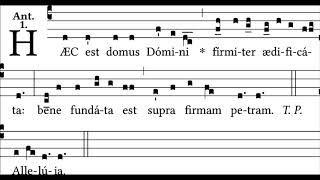According to Catholicism what is today's referent of "my house of prayer" in Isaiah 56:6-8?
6 And the children of the stranger that adhere to the Lord, to worship him, and to love his name, to be his servants: every one that keepeth the sabbath from profaning it, and that holdeth fast my covenant:
7 I will bring them into my holy mount, and will make them joyful in my house of prayer: their holocausts, and their victims shall please me upon my altar: for my house shall be called the house of prayer, for all nations.
8 The Lord God, who gathereth the scattered of Israel, saith: I will still gather unto him his congregation. - Isaiah 56: 6-8
According to Catholicism, we interpret this passage in several different ways:
- It May interpreted as every single church building (cathedrals, parish Churches of chapels) where there is a consecrated altar.
- It may be interpreted as the eternal Tabernacle in heaven, which will be our dwelling place with the Beatific Vision forever (Heb 9:11).
- It may equally be interpreted as the soul inside every believer where the Holy Spirit dwells (1 Cor 3:16-17).
- A four interpretation is in the second person of the Trinity, the Christ...
- An finally Holy Places such as Marian Grottos, which like Churches are places of worship and as such are considered sacred spaces and thus houses of prayer.
Catholic structures such as cathedrals, churches Chapels and Oratories have been considered sacred space, where the mass is normally celebrated and the sacraments are administered.
The sanctuary is the location of the altar in all churches and of the tabernacle in most. As such, it is considered sacred space and cannot be used in the manner of a simple public space.
The Code of Canon Law states:
In a sacred place only those things are to be permitted which serve to exercise or promote worship, piety and religion. Anything out of harmony with the holiness the place is forbidden. The ordinary may, however, for individual cases, permit other uses, provided they are not contrary to the sacred character of the place (can. 1210).
This is further borne out in the traditional liturgy of the Tridentine Rite within her liturgical vespers, of which the following antiphon attests to:

Haec est domus Domini
The ultimate Sacred Place for all Christians is the Beatific Vision which may be referred to as the tabernacle in heaven. It is, God willing our house of prayer par excellence where the elect will praise and adore the Divine Majesty foe all eternity. Did not Our Lord promise to made a place for us in his Father’s Kingdom. A place reserved as a majestic house of prayer filled with the saints and angels in God’s presence.
2 In my Father's house there are many mansions. If not, I would have told you: because I go to prepare a place for you. - John 14: 2
The ”house of prayer” may equally be the soul of each individual person in particular as well as that of Our Lord.
Did not Our Lord exclaim to the Jews: “Destroy this temple, and in three days I will raise it up.“
19 Jesus answered, and said to them: Destroy this temple, and in three days I will raise it up.
20 The Jews then said: Six and forty years was this temple in building; and wilt thou raise it up in three days?
21 But he spoke of the temple of his body. -John 2: 19-21
Remember that St. Peter wants us recall that we living stones chosen by God. We make up the Church of God which is a ”house of prayer”.
4 Unto whom coming, as to a living stone, rejected indeed by men, but chosen and made honourable by God:
5 Be you also as living stones built up, a spiritual house, a holy priesthood, to offer up spiritual sacrifices, acceptable to God by Jesus Christ.
6 Wherefore it is said in the scripture: Behold, I lay in Sion a chief corner stone, elect, precious. And he that shall believe in him, shall not be confounded. - 1Peter 2: 4-6
We must teach others that the Holy Spirit lives within us.
Saint Paul teaches us in 1 Corinthians 3:16-17: “Do you not understand that you are the temple of God and that the Spirit of God, the Holy Spirit, lives in you? If anyone destroys the temple of God, God will destroy them, for the temple of God is holy and so you as His temple, are holy.
“Do you not know your body is the temple of the Holy Spirit who lives within you, whom you have received as a gift from God? You are not your own. You were bought with a price purchased by Jesus’s blood. Therefore, glorify God in your body and in the Spirit, which belong to God.”
As Catholics we recognize that our flesh will one day die, and we will be given a new, resurrected body in Heaven. While on Earth, however, we must honor God by honoring our bodies. Our Bodies, His Temple
Finally Holy Places such as Marian Grottos, which like Churches are places of worship and as such are considered sacred spaces and thus houses of prayer. All Shrines and Grottos, I have visited have either a church or some other structure which is reserved for prayer, the mass and the administration of the sacraments. These include Lourdes, Fatima, La Salette, Chapel of Our Lady of Graces of the Miraculous Medal (La Rue du Bac, Paris) and Sacro Speco.

